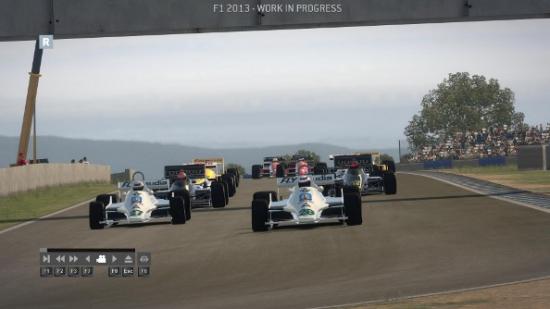After you nurse the car through the fast but unforgiving Surtees left-hander, Brands Hatch opens up into a long straight run through the English countryside, followed by a series of fast right hand turns. They’re difficult turns, not because they are particularly dangerous, but because the fastest line is so hard to find and maintain.
Good sense is whispering, “Slow down, turn in.” The laws of physics are trying to push the car off the track to the left, and the tires feel like they are starting to scrape sideways across the pavement, like all your traction is about to vanish and send your car spinning into the gravel trap and catch fencing. The wheel is alive in your hands, writhing and twisting against your efforts to hold the turn.
Formula 1 doesn’t race at Brands Hatch anymore. The turbocharged engines are gone, too, along with those lightweight rocket-sleds they were attached to. The driver sits back in a carbon fibre cocoon, surrounded by high cockpit walls in a heavier, safer car.
Sometimes it feels like something went out of the sport in the 1990s. You can feel it as you ease through Westfield Bend at Brands Hatch in a Ferrari F1/88, a car so nimble that it seems almost to dance around race tracks. There was something wonderful about those years, and F1 2013 is trying to recapture it.
F1 2013 is the first of Codemasters’ F1 racing series to include “F1 Classics”, a selection of some of the greatest cars of the 1980s and 1990s along with some of their iconic drivers. But unlike the legendary David Kaemmer racing sim Grand Prix Legends, which modeled the famous (and, with two driver deaths, tragic) 1967 Formula 1 season, F1 2013 isn’t trying to recreate any one historical era. It is instead trying to put a collection of memorable and loosely contemporary drivers and cars onto historical and modern tracks. F1 Classics mode is a sampling of some of the sport’s best years, not a recreation of them.
While F1 Classics are a new feature, they have been long in development and even longer on Codemasters’ wishlist.
“The whole process started a couple years back,” said Creative Director Steve Hood. “By January… there were enough pieces in place that we were confident in doing it this year. It’s one of the reasons the game is releasing slightly later this year. As soon as it was ready, we wanted to bring it forward.”
Hood pointed out that there is a lot of sporting and motorsports nostalgia going around this year. EA are celebrating their own sports line with anniversary editions of Madden and NHL, and later this month, Ron Howard’s picture on racing legends Niki Lauda and James Hunt, Rush, hits theaters worldwide. It was a good time for Codemasters to unveil their own tribute to the old days.
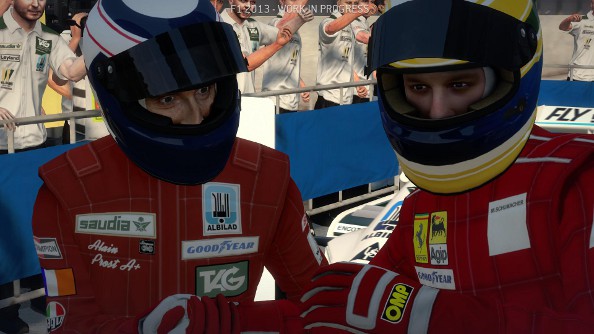
Turbos and torque
When Formula 1 was at its best is hard to say. The winningest driver in its history is Michael Schumacher, who had a near-hegemony over the sport through the end of the 1990s into the early 2000s. Along the way he fought memorable battles against Mika Hakkinen and Fernando Alonso. Sebastian Vettel appears to be on the way to replicating or surpassing this feat… yet in both drivers’ cases, there is something a bit anticlimactic about their dominance. Theirs are eras with a poverty of great rivalries, of far too many races that became victory processionals.
They are also, not coincidentally, periods of great technological ambivalence. They raced in periods when F1 arguably went backwards, trying to force drama via technical regulations rather than pursuing technological achievement. Modern F1 cars labor under a massive number of restrictions that strike at some of motoring’s signal advances of the last thirty years: anti-lock brakes, traction control, active suspension… all are banned in favor of safety and emphasizing the role of individual skill over engineering prowess. Whether those regulations have succeeded is debatable. Given how frequently the technical rules are revised, it would seem like the sport’s governing body has doubts of its own.
By contrast, the 1980s and 90s featured a number of racing legends and and massive performance gains. Niki Lauda, Alain Prost, Nigel Mansell, Emerson Fittipaldi, Gerhard Berger, and Mario Andretti are just some of the great drivers who competed in this era. There’s also the matter of Ayrton Senna, but we’ll get to that in a moment.
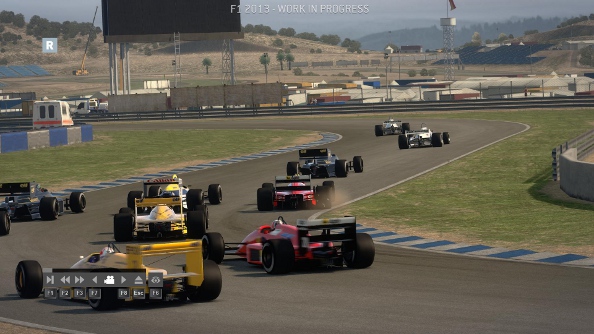
It’s also an era where engines got more powerful, when the cars’ components were pushed to the absolute limit for a single race, or sometimes even a single qualifying lap, and then cast aside, their duty done. Aerodynamics improved, cars got faster, more computer assistance arrived to support the driver. There were fewer gimmicks like the KERS-induced speed boosts and the DRS-enabled overtaking assistance. F1 did not yet need to go about trying to recover lost drama.
While there will apparently be cars from the 1990s in the final Collector’s edition of the game (1990s cars will be available to the regular edition via DLC shortly after launch, while the 80s machines come included), the 1980s models were the only one in the preview build I received. The Ferrari F1/88 was easily the best of the bunch in terms of handling… but that’s not really the point, is it?
F1 Classics are about pursuit of some more raw, more exciting quality than the surefooted, conservative excellence that’s defined F1 cars for the past several years. And the 1980s cars available here in F1 2013 do feel different, markedly different, from their modern descendants. Where the modern Red Bull and Ferrari feel heavier and more stable, almost bolted to the road at times, their predecessors from the 80s are more nervous, and often feel quicker.
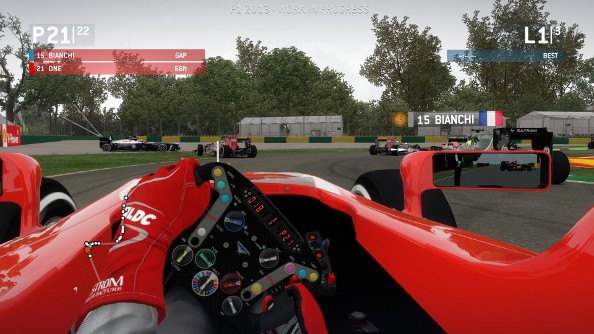
Part of it is just the sound and perspective. The 1980 Williams FW07 is a relic of a bygone era; Anakin Skywalker’s lightsaber on four wheels. Compared to any other car in the game, it is vastly inferior. But it’s also a joy to drive, with a roaring engine, growling transmission, and no electronics to speak of. It is pure power, a car to be tamed more than driven.
That goes double for the 1986 Lotus, a turbocharged monster that seems to explode out of corners and teleport itself to another location with every twitch of the wheel. The turbo punctuates every maneuver with a gasp of its own, but the most striking feature of the Lotus is just how aggressive and unforgiving it can be. Well-handled, it’s an astonishingly responsive and nimble car, one of the most exciting rides in virtual racing. It’s the thrill-ride that arcade racers can only counterfeit with speed-boosts and overdone drifts.
But I’m pretty sure it also wants me dead. Taking it around the same Brands Hatch circuit where the Ferrari sang, I realized that controlling the Lotus was a physically different task than the Ferrari. The Ferrari was more traditional: hit a braking point, turn-in, increase the power on the exit.
But the Lotus needed to be coddled, at its happiest when it was on the cusp of losing control. Any sudden application of power and the rear wheels would step out, the nose would veer to the left, and I was on a fast trip to the nearest tire wall. But if I was too careful, the car would be sluggish and sullen. Driving it involved constant throttle management, adding a little brake here and there to make a turn. It was odd, at times frustrating, but always thrilling. Doubly so because the car design leave the player perched at the front like Wile E. Coyote on the nose-cone of an ACME rocket.
I hate it. I love it. I’d happily play an entire game about it.
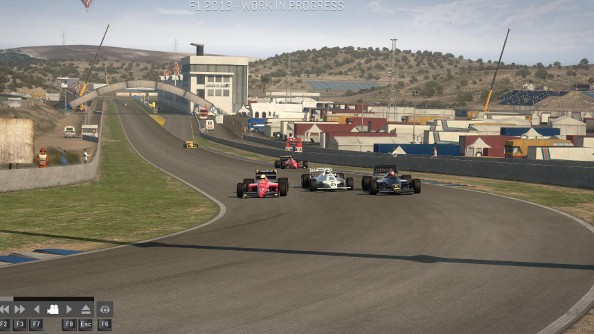
Licensing the past
Steve Hood explained why that’s a tricky proposition. “The further back you go, the harder it tends to be. This sport itself only really turned out to be a proper sport in the early 80s… so anything pre 1980 really gets quite muddy in terms of what you can and can’t do, and who owns the licenses on various teams which don’t exist anymore. In terms of recreating a particular season, the further back you go it gets harder and harder and harder.”
That said, Codemasters are constantly working to get permission for more cars and drivers in the next editions of F1. At one point they considered re-creating specific races from F1 history, but the complexity of getting licensing rights for long-defunct teams killed that idea. Nevertheless, Hood admits that he has fond memories of Grand Prix Legends and would love to be able to offer some similar historical racing. It’s just not something that was feasible with the 2013 edition.
“We would love to do it for sure,” he said. “Whether our licensing team have the strength to see it all through, I’m not sure. I think there’s a huge appetite for 50s and 60s and 70s – everyone has a different car and driver combination they would like to see. I’d love to do something a bit more around different world champions in different eras. The ambition is definitely there, it’s just what we can do with the different licensing.”
Nowhere does that issue get more fraught than with Ayrton Senna.
“With Senna in particular, we encountered two difficulties,” Hood explained. “The first being that McLaren had indicated they had an exclusive deal with a couple of other people. So having Senna without McLaren would have been less than ideal, but it wouldn’t have absolutely been a deal breaker. Then there’s actually a Brazilian PC developer that were planning to release a Senna game this year, I think, but I’m guessing it’s not going to come out this year. So we had to go the Senna Foundation, then we had to speak to the other guys to speak about the negotiating some extra rights of theirs in bits and pieces. So the talks are progressing, but it was far too much risk to try and get it in to the content for this year.”
Codemasters sounds confident that eventually, Senna will find his way into the F1 series, just as future version will expand their roster of classic cars and drivers. Perhaps they will even get enough cars to have more realistic races between contemporaries, rather than the F1 fantasy scenarios that define “F1 classics” mode at the moment.
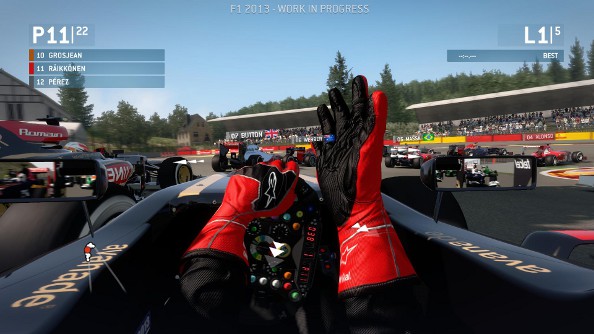
The hero driver
Those scenarios are pretty good, though. Both the regular game and “F1 Classics” include racing “missions” that cut right to chase.
For instance, one classic event puts you in that sluggish Williams at the very front of the grid… ahead of a bunch of much faster cars. The entire thing is just a desperate defense from beginning to end, first dueling with your teammate alongside you, then fending off challengers in faster cars as they press closer. Another scenario, for modern F1, puts you in the benighted Marussia F1 car at Melbourne, and you have only a few laps to overtake your teammate in a dense grid.
These scenarios might be a bit contrived, but they are also shortcuts to some of the best moments in a racing game. Much of F1 racing is method and precision, which can be rewarding but not as adrenaline-pumping as wheel-to-wheel combat. The scenarios of F1 2013 offer quick hits to players who don’t feel like leaving racing action to chance.
Still, Codemasters are taking care of those of us who are maniacal enough to do full race weekends and long races. For the first time ever, F1 2013 brings in-race saves to the series, meaning that you no longer have to choose between a realistic virtual racing career and one that actually fits into a normal schedule. Now you can drive the first twenty laps of a Grand Prix, save, and pick up the rest on the weekend.
What makes F1 2013 different from its predecessors is that it’s not really about one kind of F1, or one particular vision of what racing should be. From the more nuanced driver aids it offers to in-race saves to scenarios to F1 Classics, F1 2013 is about giving players their ideal of what F1 racing should be. In whatever form they want, with whatever help they need. There may not be a Senna in this edition, but with everything Codemasters have made available, there’s more than enough chances for you to play his part.
